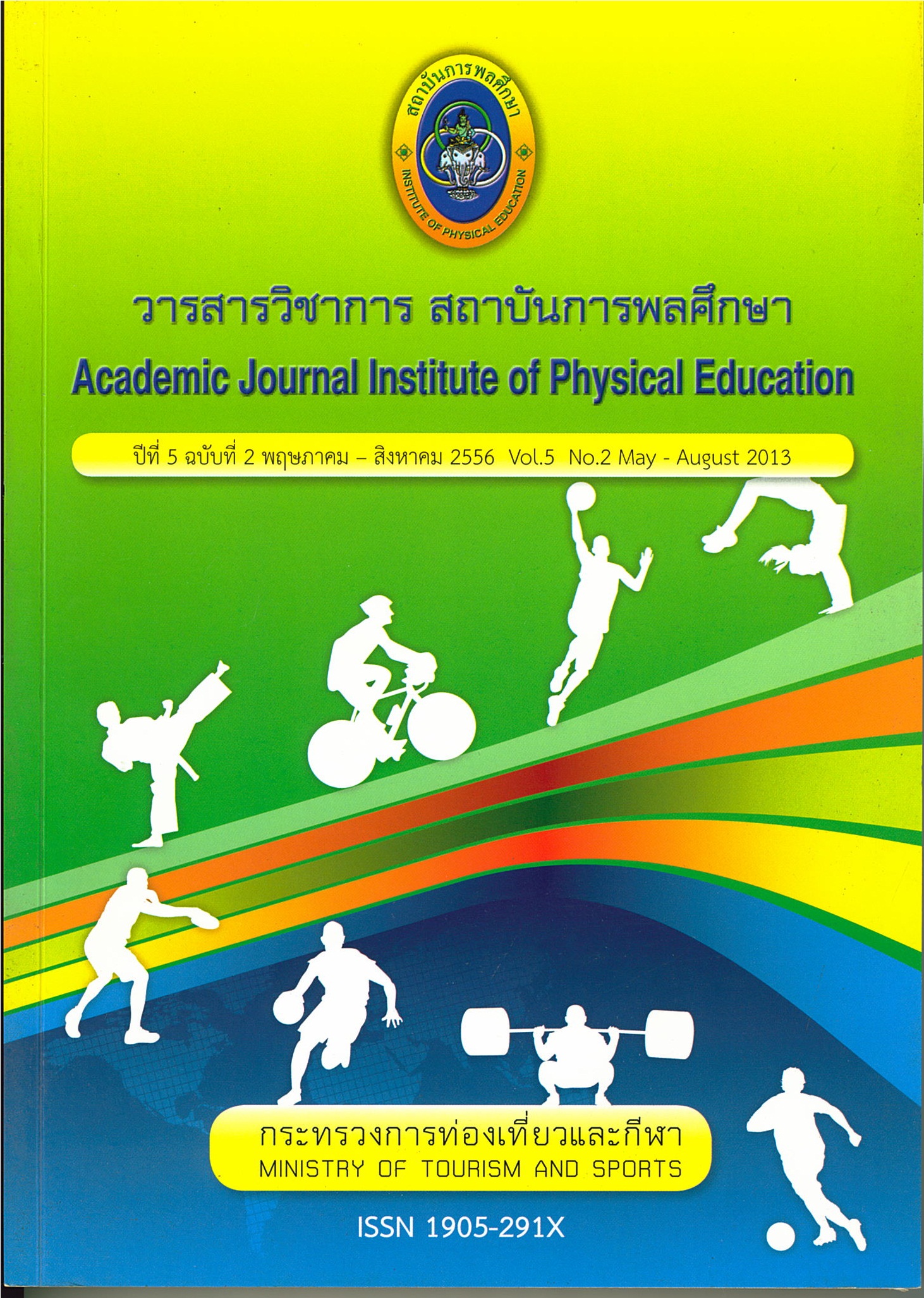THE STUDY OF SACCADIC EYE MOVEMENT SPEED AND CHOICE RESPONSE TIME TO VOLLEYING ABILITY AND DIFFERENCES STYLE OF TENNIS PLAYER
Main Article Content
Abstract
The purpose of this research were to study the relationship between Saccadic Eye Movement Speed (SEMS) and Choice Response Time (CRT) of the dominant hand and tennis volleying ability and from two differences style of tennis player. Subjects were taken from 60 advanced tennis players, at least 2 years of competitive experiences, aged between 14-30 years. Each of the 2 groups consisted of 30 tennis players. The first group was represented for a serve-volley style and the other is for baseliner players. The researcher has constructed an instrument to collect the SEMS and CRT data, and used the Dyer test for tennis volleying ability. Scale reliability analysis showed the instrument reliability was 0.78. Pearson co-efficient analysis was used to find out the relation on The mean differences of SEMS and CRT were between two groups were found significantly independent and the mean differences of the volleying abilities between two groups were also found significantly independent. The finding of the research indicated that: There were significantly relation between SEMS and CRT of the dominant hand and the tennis volleying ability at 0.1 level. (r = -0.460). There were significantly differences at 0.5 level on SEMS and CRT between serve-volley style and baseliner style. The mean times of SEMS and CRT were 0.48 millisecond and 0.57 millisecond respectively. There was significantly difference at 0.5 level on tennis volleying ability between serve-volley style and baseliner style. The mean-scores of tennis volleying ability were 42 and 32 respectively.
A conclusion is for a successful tennis player, the one who has a good Saccadic Eye Movement Speed (SEMS) and Choice Response Time they are also has good volleying ability and the serve-volley style tennis player has Saccadic Eye Movement Speed (SEMS)-Choice Response Time (CRT) and volleying ability better than the baseliner
style.
Article Details
The published article is a copyright of the Academic Journal of Thailand National Sports University. The passage appeared in each article in this academic journal is a perspective of each author which is not related to the journal. Each author is required to be responsible for all components of his/her own article. If there are any mistakes, each author must be responsible for those mistakes on his/her own.
References
จรวยพร ธรณินทร์. (2522). กายวิภาคและสรีรวิทยาของการออกกําลังกาย, กรุงเทพฯ: ไทยวัฒนาพานิช.
ชนะชัย ศรีชาพันธ์. (2546) ปั้นลูกให้เป็นแชมป์, กรุงเทพฯ: เนชั่นบุ๊คส์.
ชูศักดิ์ เวชแพศย์ บุญงาม แสงไขมุกข์ และปราณี เจียมรวมวงศ์. (2518), รายงานการศึกษารีแอคชั่นไทม์. กรุงเทพฯ: ชมรมสรีรวิทยาแห่งประเทศไทย,
ชูศักดิ์ เวชแพศย์, สรีรวิทยา. (2520). กรุงเทพฯ: อักษรสยาม.
Bairstow, J. (1976). Meet the New King of the Serve. Tennis. 12: 30-33.
Bizzi, E. (1974). The Coordination of Eye-Head Movements. Scientific American. 321: 100-106.
Borg, B. (1977). How to Stay Mentally Sharp on Court. Tennis. 2: 42-45.
Crespo, M., and Miley D. (1998). ITF Advanced Coaches Manual. London, England: International Tennis Federation.
Gay, J. A., and Bellucci, R. D. (1974). Eye Movement Disorders. Saint Louis: The C.V. l Mosby.
Gilbert, B., and Jamison, S. (1993) Winning Ugly. New York: Kensington.
Gullikson, T. (1994). How to beat anyone, anytime. Tennis 3: 32-41.
Harriet, W. G., and Janet, H. (1997). Saccadic Eye Movement Speed and Motor Response Execution. Research Quarterly in Exercise and Sport. 43: 598-605.
Howard, I. P. (1970). The Adaptability of the Visual-Motor System. In K. Connolly (ed.). New York: Academic.
Hubbard, A., and Seng, C. (1954) Visual Movement of Datters. Research Quarterly. 25: 42-43.
Newcombe, B. (1992) Tactics of Success Tennis. Ward Lock: Great Britain.
Roetert, P. and Groppel, J. (2001). World - Class Tennis chnique. England: Human Kinetics.
Schonborn, R. (2000) Advanced Techniques for Competitive Tennis. Oxford: Meyer & Meyer Sport.


